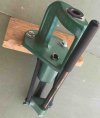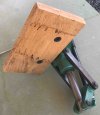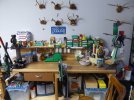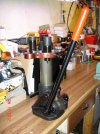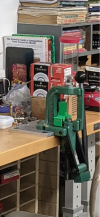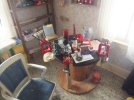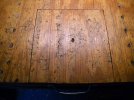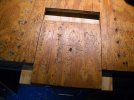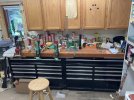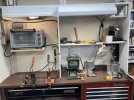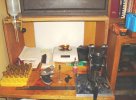Many viable ways and all so far seem perfectly appropriate to me, with preference for one means over another being more about what you have available.
If I'm mounting a press to a board to clamp onto another surface, I PREFER to use a piece of solid hardwood. a 12" long piece of 3/4" oak, maple, hickory, etc. is plenty, even with bolt-heads counter-sunk in the bottom, with a washer. 1/4" to 5/16" bolts/flat-washers/lock-washers, with the nuts on top.
The width would be the width of the press' foot-print, plus at leas half an inch on each side. The reason for the length is that the leverage afforded reduces the flex and stress effected on the surface to which the press is mounted. TWO c-clamps, one fore and one aft really makes it easier on the work-surface, especially if it's something in your home.
Currently, my single-stage LEE O-press is mounted to a piece of hickory and clamped to a bench when I need to size bullets or deprime a bunch of "new," used brass. The Lyman 45 is similarly mounted on a piece of maple, using nothing more than #10 cabinet screws and I've put more stress on that press - in BOTH directions - than is sensible, without the press moving or stressing something else.
Since I have always had some type of construction project, furniture/cabinet work in-process, I've always had access to a variety of building materials, which may not be the case for everyone. Stop at a constriction site and bum a piece of plywood, or better yet, stop at a cabinet shop and bum a piece of hardwood. Most often, if you offer compensation, they'll ave you off. Short of that, the home-centers or lumber companies will cut you a piece for a small fee. Sometimes, the "fee" is nothing more than a little patience. I add this because, while REAL, QUALITY plywood is amazing stuff, any plywood I've bought in my lifetime has gotten worse each year, and since 2020, it's pretty much a waste of resources - garbage.
My current favorite-of-all-time permanent mount is a 1" thick slab of PVC, to which the press is screwed from the top, and the slab is screwed to 7/8" thick hickory bench-top from below. 1/4" machine SCREWS (no nuts), with the holes in the PVC slab D/T'd to minimum clearance. A bit extravagant, elaborate and definitely overkill, but I had the material and was tired of the "temporary" pine slab I had been using for probably 30 years.
A board if sufficient. The one point I'd stress most is making the board a little longer than the front to back foot-print of the press. Takes a lot off stress of the surface you're attaching it to.

